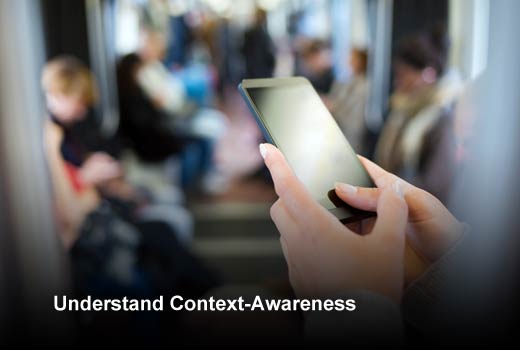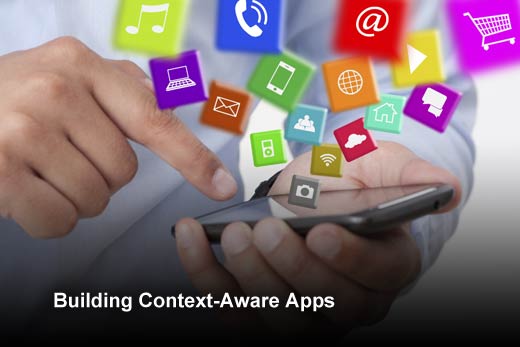Developing an application that is used frequently by a specific audience requires a rigorous design and development process. This includes defining the app’s goals and objectives, determining its features and functionality, designing a user experience that is both engaging and delightful and building the underlying architecture and analytics that will support the functions of the app — even before writing the first line of code.
Mobile devices are arguably the best way to deliver messages at the right time and place given their always-on nature. So, when building a mobile app with the goal of being useful and engaging, making it a context-aware app is ideal.
Context-aware applications, or CAAs, are the next generation of intelligent mobile applications. When allowed by their users, these apps use contextual data: from historical information about the user’s demographics and behavior profiles to data about the current surroundings obtained through the smartphone’s microphones, accelerometers, gyroscope, cameras and other sensors. Combining these inputs with the current time and location via GPS, CAAs paint a picture about the user’s immediate context, and use the information to deliver tailored experiences in the form of timely, relevant and appropriate information, notifications and/or functionality. As compared to other apps, CAAs sustain a user’s attention and are more effective at influencing or changing behavior.
But where do you start? In this slideshow, Gary Rozal, Ph.D., vice president, Analytics at Mobiquity, has identified five steps for developing the next evolution of mobile apps.
Five Steps for Developing Context-Aware Apps
Click through for steps organizations should consider when developing contextually aware apps, as identified by Gary Rozal, Ph.D., vice president, Analytics at Mobiquity.
Understand Context-Awareness
Step One: Understand context-awareness.
A context-aware mobile application is an app that uses context – any information that can be used to characterize the situation of a person or object – to provide information and services relevant to the task. “Context” is any relevant data or information that may influence user engagement with the application and their subsequent behavior. An application is “context-aware” whenever context – whether implicit (sensor data, user profile or historic behavior) or explicit (entered/chosen preference) – is used to improve the user’s experience, resulting in increased engagement and a change in behavior.
Building Context-Aware Apps
Step Two: Know the difference between building an app versus building an app with context awareness.
Mobile applications need to be designed through a multi-disciplinary lens, including business strategy, user experience and technology considerations. Context awareness, however, presents an opportunity to build disruptive mobile solutions by recognizing, incorporating and leveraging information from new data sources. Organizations need to include contextual information as a key component in the application design to build new mobile solutions or enhance existing ones. Developers looking to create context-aware apps need to start from a catalog of contextual variables to spur initial ideas and adopt an iterative approach to identify and refine user stories that leverage context-awareness.
Think Outside the Box
Step Three: Set an initial target and think outside of the box.
First, it’s crucial to determine the key goals to enhance with context-awareness, from either an existing application or new business requirements. What behaviors are you hoping to encourage or change from your users? How would you like these behaviors to impact your business? Then it’s time to get creative – select relevant context variables and create related user stories to tackle target goals. Don’t forget to revisit and revise your context variables as you fine-tune the program.
Assess Value
Step Four: Assess the value and feasibility.
The value of contextual variables depends on the application. Determine the added business and customer value to prioritize the contextual variables to be included in the mobile solution. Make sure to also determine the method and technology necessary to collect, transform and integrate the contextual variables considering information accuracy, ability or cost of gathering that information and the impact on user experience. Because building an effective CAA sometimes necessitates the collection of personal, location-based data, it is crucial to state the benefits of providing such information and how it will be used so that the user will grant access. The goal of providing transparency about data usage is to build trust with the user instead of raising fear.
Consider the Challenges
Step Five: Get acquainted with the technical challenges and considerations.
CAAs are the next generation of intelligent apps, and while they go beyond personalized, location-based messaging, it is not a bad idea to begin building context data by linking user profiles and demographics with past activities, app behaviors and purchases as a starting point. But there are a few things to keep in mind:
- While lots of effort should go into collecting user information, in the case of privacy-sensitive applications such as HIPAA-compliant medical apps, the user can be de-identified while keeping a record or token that allows the app to still learn personal preferences and provide contextual interactions.
- A smartphone’s sensors can be used to receive additional context data. The more context data an app can collect – i.e., Big Data – the more information can be provided to the user. But in order for this data to be useful to the app and the user, the data usually needs to be analyzed in real-time, or risk becoming stale and irrelevant. A Big Data architecture may be required so the app can return useful information quickly.
- Inferred information from context data is another issue to consider in terms of accuracy – what if the information derived from context is so far from reality that the app behaves unexpectedly? What can be done to mitigate such an event, and achieve a reasonable user experience under such risk?
Conclusion
Just as automation has become standard in computing, context-awareness is becoming an essential user expectation of mobile, and the opportunity window to innovate and differentiate ways of leveraging context is quickly narrowing. Context-aware features are more automated and transparent to the end user, which is speeding up the commoditization of contextual information. Organizations need to act fast in order to achieve competitive advantage and reap the most benefits from a highly competitive and fast-moving market.









